In 1935, the entire German Armed Forces, the prince subject of rearmament, took the name Wehrmacht, whose Supreme Command was called Oberkommando der Wehrmacht (OKW); it included the Heer, the Army, whose Supreme Command was called Oberkommando des Heeres (OKH), the Luftwaffe, the Air Force, whose Supreme Command was called Oberkommando der Luftwaffe (OKL) and on which the paratroopers also depended, the Kriegsmarine, the Navy, and the Waffen-SS. Unlike the staffs of other armies, both Allied and Italian, the Germans, after their experience in World War I, were very clear that the next one would not be fought in the trenches.
The Heer, the Army's ground forces.
The belief of the General Staff of the German Army (Heer) that a new war would be very different from any that had been fought up to that point began to take shape after the appearance of the tank at the end of World War I. Because of the restrictions imposed by the Treaty of Versailles, experience with this new weapon was gained underground and often in training camps in the Soviet Union. Preparations for World War II in the pre-war period saw the development of a program centered on close cooperation between armored forces, aviation, and mechanized infantry, with masses of tanks launched to break through enemy lines and wreak havoc in the rear under the cover of aviation. Warfare became aggressive and based on speed of movement: blitzkrieg. All of this was based on training and new tactics, as the first German tanks were qualitatively not very well armored and the armament was not so fearsome, but relied mainly on speed on the battlefield.
At the start of the war, infantry weapons were a combination of tradition, the Mauser 98 or the short Karabiner 98k version, and modernity, the Maschinenpistole 1938 or MP38, a machine gun designed by Heinrich Vollmer. The 98k was an excellent revolving bolt rifle that fired 7.92 x 57 mm ammunition, while the MP38, although expensive to produce, fired 9 x 19 mm parabellum ammunition and was suitable for close combat. When the Germans came into possession of the Tokarev semi-automatic rifle captured from the Soviets, they realized that they also needed to equip themselves with a similar weapon. The .41 rifle produced by Mauser and Walther was proposed in two different models, both of which were unreliable. In 1943, Walther proposed a new model that combined the best features of its earlier G41 model with new developments; the Gewehr 43 then entered service and from 1944 assumed the name Karabiner 43. During the war, several new weapons were produced, starting with the MP40, which had the same characteristics as the MP38, but was made of stamped and welded plates, making it less expensive to produce. Between 1941 and 1943, the Fallschirmjäger Gewehr 42 or FG42 was developed, an automatic rifle supplied to Luftwaffe paratroopers and considered by many to be the first assault rifle in history. Around the same time, development of the Sturmgewehr 44 assault rifle began. Born from an early model called the MKb42, which later evolved into the MP43 and MP44, the Stg44 was a revolutionary weapon that changed the face of infantry. The Soviet AK47 was inspired by the MP44 in both design and ammunition. These weapons became indispensable in close combat on battlefields where the German army was struggling, if not retreating, on several fronts.
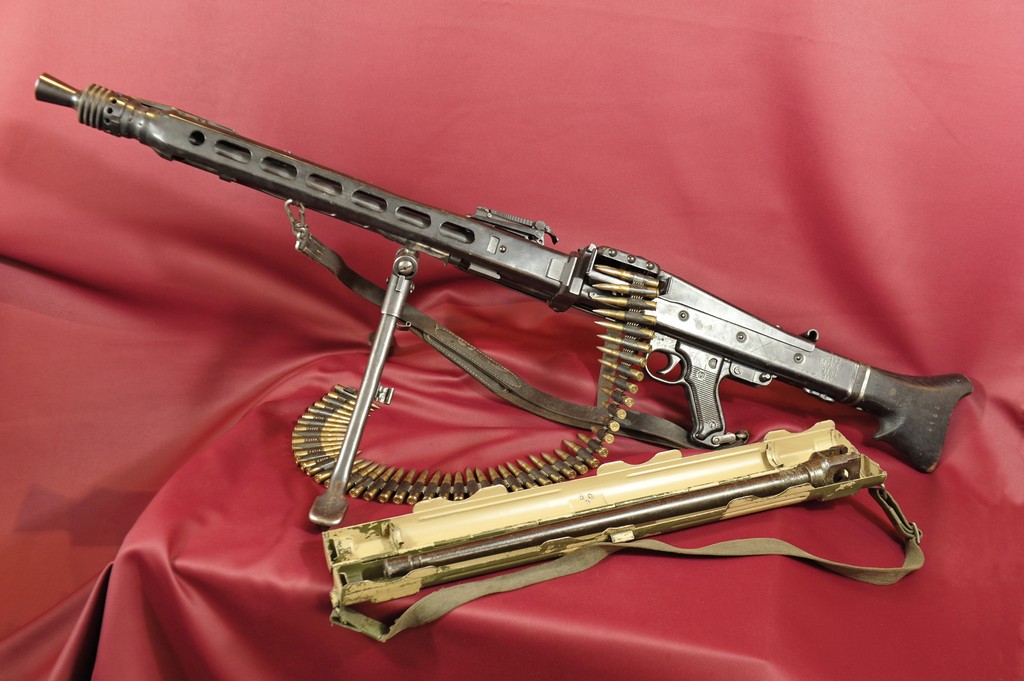 As far as machine guns were concerned, the German Army had entered the war with the Mauser Maschinengewehr 34 or MG34, fed by 200-round belts or 50-round assault magazines. A jewel of mechanics, it fired 7.92 x 57 mm ammunition and had a rate of fire of 1,000 rounds/minute, but this Teutonic precision made it prone to functional problems, especially in critical conditions of use, due to the poor tolerances of the fine machining, all done by lathe and milling machine; not least played to its disadvantage the long production time and the consequent high cost. It was almost immediately replaced in production by the Maschinengewehr 42. The MG 42 immediately proved to be an excellent squad machine gun, built from stamped sheet metal, quick to build, reliable, and with a very high rate of fire of 1200 rounds/minute, it used the same ammunition and charges as the MG34. It turned out to be one of the best machine guns of its time and beyond, so much so that it is still in service in several armies, including the Italian in the MG 42/59 model with NATO 7.62 x 51 mm ammunition and a lower rate of fire of around 800 rounds/minute.
As far as machine guns were concerned, the German Army had entered the war with the Mauser Maschinengewehr 34 or MG34, fed by 200-round belts or 50-round assault magazines. A jewel of mechanics, it fired 7.92 x 57 mm ammunition and had a rate of fire of 1,000 rounds/minute, but this Teutonic precision made it prone to functional problems, especially in critical conditions of use, due to the poor tolerances of the fine machining, all done by lathe and milling machine; not least played to its disadvantage the long production time and the consequent high cost. It was almost immediately replaced in production by the Maschinengewehr 42. The MG 42 immediately proved to be an excellent squad machine gun, built from stamped sheet metal, quick to build, reliable, and with a very high rate of fire of 1200 rounds/minute, it used the same ammunition and charges as the MG34. It turned out to be one of the best machine guns of its time and beyond, so much so that it is still in service in several armies, including the Italian in the MG 42/59 model with NATO 7.62 x 51 mm ammunition and a lower rate of fire of around 800 rounds/minute.
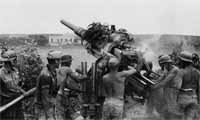 Given the prohibitions imposed on Germany by the Treaty of Versailles at the beginning of World War II, artillery was modern in both heavy, anti-aircraft, and especially anti-tank specialties. As tanks became more armored and faster, anti-tank artillery evolved from 3.7 to 5 and 7.5 cm. By the time they entered the war, the 8.8 cm Flak 18 anti-aircraft guns had also proved very effective in the anti-tank role. The 8.8 cm Pak 43 anti-tank version entered service in 1943 and was used mainly in the North African theater along with the Flak 18 and Flak 36, which were too high and thus more exposed to enemy artillery fire. Anti-tank weapons became increasingly important on the battlefield as the Allies, after America entered the war, had thousands of tanks that were medium armor but fast. A simple, inexpensive, disposable personal weapon, namely a hollow-charge rocket-propelled grenade launcher against a tank, was therefore designed and produced: the Panzerfaust. In its five models it had a useful range of 30 to 150 meters and could penetrate armor from 140 to 300 mm.
Given the prohibitions imposed on Germany by the Treaty of Versailles at the beginning of World War II, artillery was modern in both heavy, anti-aircraft, and especially anti-tank specialties. As tanks became more armored and faster, anti-tank artillery evolved from 3.7 to 5 and 7.5 cm. By the time they entered the war, the 8.8 cm Flak 18 anti-aircraft guns had also proved very effective in the anti-tank role. The 8.8 cm Pak 43 anti-tank version entered service in 1943 and was used mainly in the North African theater along with the Flak 18 and Flak 36, which were too high and thus more exposed to enemy artillery fire. Anti-tank weapons became increasingly important on the battlefield as the Allies, after America entered the war, had thousands of tanks that were medium armor but fast. A simple, inexpensive, disposable personal weapon, namely a hollow-charge rocket-propelled grenade launcher against a tank, was therefore designed and produced: the Panzerfaust. In its five models it had a useful range of 30 to 150 meters and could penetrate armor from 140 to 300 mm.
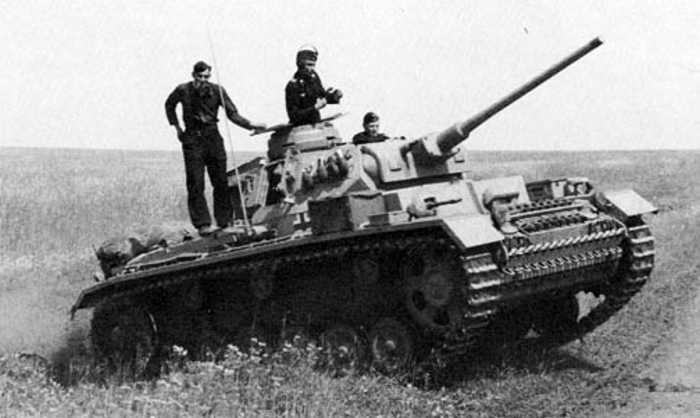 In the Polish and French campaigns the principle of mobility was interpreted by the 10-ton and 20-ton Pzkfw II and Pzkw III tanks, the former armed with a 20mm machine gun, the latter with a 50/42mm cannon and a supply of more than 90 rounds. Both could reach a road speed of 40 km/h compared to 24 km/h on road and 12 km/h on dirt of the British Matilda tanks. This speed advantage came at the expense of armor, which is the least of the requirements in the tank design formula of mobility/firepower/protection. Also in the field were the Pzkfw IV of 22 tons and armed with 75/24 mm cannon first, later 75/43 and 75/48, the escort was 80 rounds. The armor went from the maximum 30 mm of the II and III to the 80 mm of the IV, while maintaining a speed of 42 km/h on the road and 20 km/h on the dirt, proving that the German idea of using the vehicle was not only for infantry support but as a weapon to be used en masse to break through enemy lines and open the way for motorized infantry to complete the conquest of territory.
In the Polish and French campaigns the principle of mobility was interpreted by the 10-ton and 20-ton Pzkfw II and Pzkw III tanks, the former armed with a 20mm machine gun, the latter with a 50/42mm cannon and a supply of more than 90 rounds. Both could reach a road speed of 40 km/h compared to 24 km/h on road and 12 km/h on dirt of the British Matilda tanks. This speed advantage came at the expense of armor, which is the least of the requirements in the tank design formula of mobility/firepower/protection. Also in the field were the Pzkfw IV of 22 tons and armed with 75/24 mm cannon first, later 75/43 and 75/48, the escort was 80 rounds. The armor went from the maximum 30 mm of the II and III to the 80 mm of the IV, while maintaining a speed of 42 km/h on the road and 20 km/h on the dirt, proving that the German idea of using the vehicle was not only for infantry support but as a weapon to be used en masse to break through enemy lines and open the way for motorized infantry to complete the conquest of territory.
The Panzer IV was joined by the Pzkfw VI Tiger and the Pzkfw V Panther.
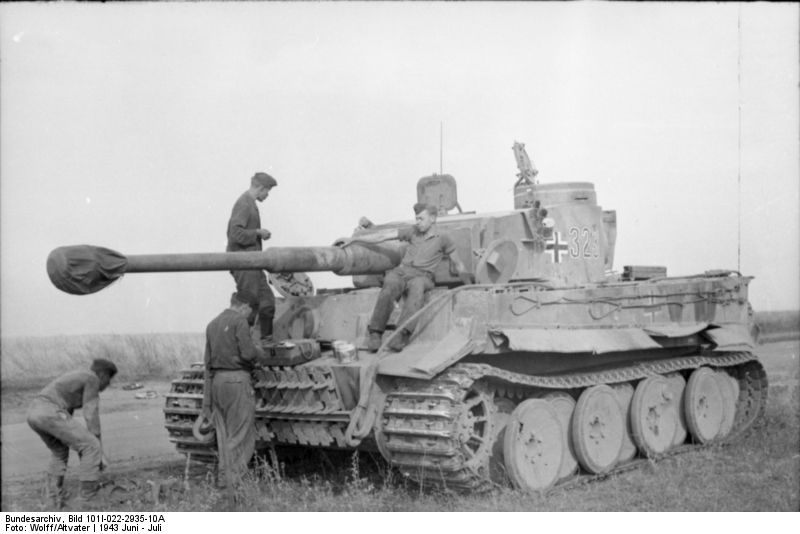 The Pzkfw VI Tiger was designed to be superior to all enemy tanks. It entered service in 1942 equipped with an 8.8-cm KwK 36 L/56 anti-tank gun that allowed it to pierce the armor of any British and American tank at over 1,500 meters. It had a 93-round reserve and 140 mm of frontal armor. It was powered by a Maybach gasoline engine, 12 V-cylinder, 700 hp reached a speed of 40 km/h on the road and 20 km/h on dirt. Its limitation and weak point was its weight: 57 tons which made it particularly unsuitable for rough terrain or bridges that were not more than sturdy.
The Pzkfw VI Tiger was designed to be superior to all enemy tanks. It entered service in 1942 equipped with an 8.8-cm KwK 36 L/56 anti-tank gun that allowed it to pierce the armor of any British and American tank at over 1,500 meters. It had a 93-round reserve and 140 mm of frontal armor. It was powered by a Maybach gasoline engine, 12 V-cylinder, 700 hp reached a speed of 40 km/h on the road and 20 km/h on dirt. Its limitation and weak point was its weight: 57 tons which made it particularly unsuitable for rough terrain or bridges that were not more than sturdy.
It was not until 1944 that production was progressively reduced until it ceased in the face of the development of opposing anti-tank weapons: the Soviet 12mm gun and the British 25-pound gun could pierce the Tiger's frontal armor at 1,500 meters. More than 1,300 were produced.
The Pzkfw V Panther, which entered service 1943, was much lighter and more maneuverable than the Tiger. Designed to be more agile than the T34 and more protected than the Soviet KV1 heavy tank it was equipped by the 75/70 mm gun whose performance was slightly inferior to the 88 mm gun. It had a reserve of 82 rounds and although powered by a 700-hp engine like the Tiger had twice the range and reached a speed of 46 km/h on the road and 30 km/k on dirt despite weighing 45 tons. More than 5,500 examples were produced.
Bibliography:
The German Assault Rifle 1935-1945 by Peter R. Senich
The German Machine Gun - Revised Edition - by Daniel D. Musgrave
Der Panzer-Kampfwagen PANTHER und seine abarten by Walter J. Spielberger
Panzerkampfwagen TIGER by Uwe Feist & Bruce Culver
The Luftwaffe, the airborne and paratroop forces of the Wehrmacht.
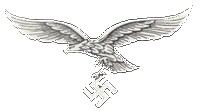
The Luftwaffe was created during World War I, when the usefulness of the airplane on the battlefield became apparent, both as an observer and reporter on the movements of the enemy army and the disposition of its artillery, and as a dive bomber, since it was the most accurate mode in the absence of effective targeting devices. The Luftwaffe was later disbanded at the end of the war under the terms of the Versailles Treaty. Despite the prohibitions of the Treaty of Versailles, a small air force was secretly set up as early as 1926, and pilots were secretly trained, mostly on the aircraft of civilian airlines. The Luftwaffe was re-established in secret in 1933. The birth of the Luftwaffe was made public in March 1935, and Hitler placed Hermann Göring, the German ace of World War I, at the head of its supreme command.
Some contingents had the opportunity to refine techniques and propose aircraft upgrades when they were sent between 1936 and 1937 to support General Francisco Franco's forces during the Spanish Civil War, helping his victory and the establishment of the dictatorship. At the beginning of World War II, the Luftwaffe was the most powerful air force in the world, with about 4,000 aircraft, including about 2,500 combat aircraft. Its aircraft were at the heart of the German Blitzkrieg in Poland and Holland.
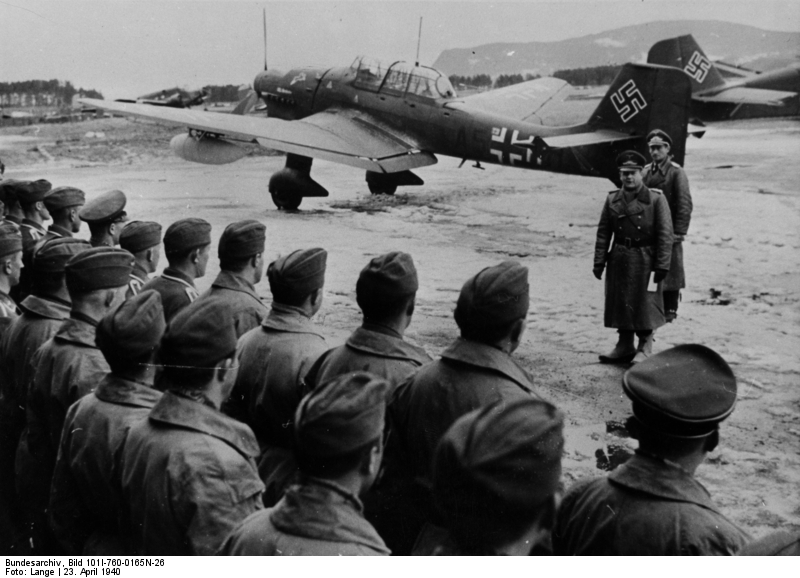 At the beginning of the war, the use of Junkers Ju87 Stuka (short for Sturzkampfflugzeug) dive bombers, with the howl of their powerful sirens as they plunged to the ground, terrorized the populations of attacked and bombed cities and towns. The aircraft, capable of extremely precise bombing at a speed of 350-390 km/h, was very slow, and already in the Battle of Britain, despite the availability of more powerful 1200 and 1400 hp engines, it was withdrawn from the skies because of the many shootdowns by British Spitfires flying at 550-600 km/h. Paradoxically, the successful dive-bombing experience of the Ju87 Stuka in Spain was the strategic undoing of the Luftwaffe and consequently of Germany. In the years between 1932 and 1935, when the development and direction of military aviation in Germany was being decided, there were two schools of thought, one arguing for the importance of strategic high-altitude four-engine bombing, and the other arguing that aviation should exclusively support ground troops, in addition, of course, to countering enemy aviation. It was precisely the experience in Spain that tipped the scales in favor of dive bombers and away from large strategic bombers such as the Ju89 and Do19.
At the beginning of the war, the use of Junkers Ju87 Stuka (short for Sturzkampfflugzeug) dive bombers, with the howl of their powerful sirens as they plunged to the ground, terrorized the populations of attacked and bombed cities and towns. The aircraft, capable of extremely precise bombing at a speed of 350-390 km/h, was very slow, and already in the Battle of Britain, despite the availability of more powerful 1200 and 1400 hp engines, it was withdrawn from the skies because of the many shootdowns by British Spitfires flying at 550-600 km/h. Paradoxically, the successful dive-bombing experience of the Ju87 Stuka in Spain was the strategic undoing of the Luftwaffe and consequently of Germany. In the years between 1932 and 1935, when the development and direction of military aviation in Germany was being decided, there were two schools of thought, one arguing for the importance of strategic high-altitude four-engine bombing, and the other arguing that aviation should exclusively support ground troops, in addition, of course, to countering enemy aviation. It was precisely the experience in Spain that tipped the scales in favor of dive bombers and away from large strategic bombers such as the Ju89 and Do19.
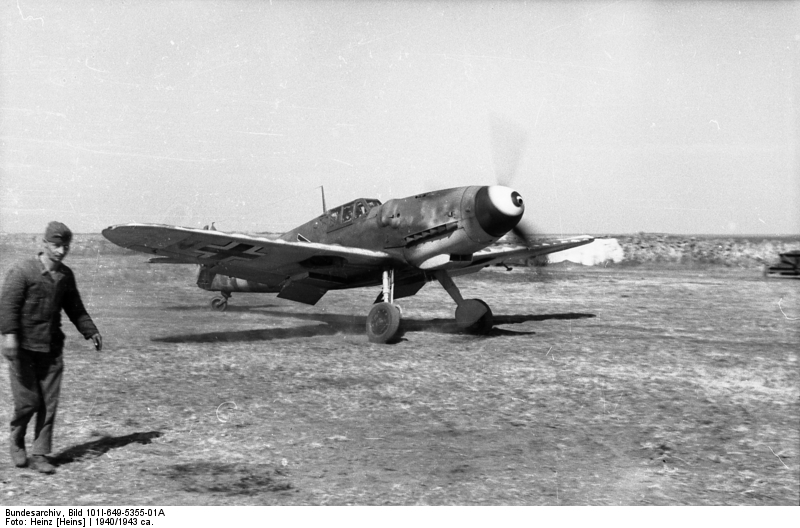 Between 1939 and 1945, Germany produced more than 50,000 fighter aircraft, including more than 30,000 Messerschmitt Bf 109 fighters and 20,000 Focke Wulf Fw 190 fighter bombers. The first Bf 109s, which flew between 1935 and 1936, were not very fast and had Junkers engines with just over 600 hp. It was not until 1938, with the development of the Daimler Benz's V-shaped axial engines, which could produce up to 1,800 hp in the DB 605 version, and the specific armament, which varied according to the version required, that the Bf 109 became an aircraft that could keep up with the enemy. It surpassed them in climb speed and acceleration, but above all it was able to dive immediately without loss of fuel flow to the engine, since it was powered by direct injection. The Focke Wulf 190 entered service in 1941 and was equipped with a 1600 hp BMW 801C radial engine, as opposed to the Bf 109's V-shaped axial engine, and was faster than the Spitfire. Armament was excellent and consisted of two 13mm machine guns and a 20mm cannon. Multirole aircraft were used as both bombers and torpedo bombers. In the fighter class, the Messerschmitt Bf 110 was a twin-engine heavy fighter that was often used as a night fighter late in the war. It entered service in 1938 and was powered by a DB601 engine and later by the DB605. The specialized version as a night fighter had a radar on board and was armed with four MG17 machine guns and two 20 mm cannons and to which were added two more in the rear of the cockpit that fired upward since the German tactic ara to attack Allied aircraft from behind and at lower altitude.
Between 1939 and 1945, Germany produced more than 50,000 fighter aircraft, including more than 30,000 Messerschmitt Bf 109 fighters and 20,000 Focke Wulf Fw 190 fighter bombers. The first Bf 109s, which flew between 1935 and 1936, were not very fast and had Junkers engines with just over 600 hp. It was not until 1938, with the development of the Daimler Benz's V-shaped axial engines, which could produce up to 1,800 hp in the DB 605 version, and the specific armament, which varied according to the version required, that the Bf 109 became an aircraft that could keep up with the enemy. It surpassed them in climb speed and acceleration, but above all it was able to dive immediately without loss of fuel flow to the engine, since it was powered by direct injection. The Focke Wulf 190 entered service in 1941 and was equipped with a 1600 hp BMW 801C radial engine, as opposed to the Bf 109's V-shaped axial engine, and was faster than the Spitfire. Armament was excellent and consisted of two 13mm machine guns and a 20mm cannon. Multirole aircraft were used as both bombers and torpedo bombers. In the fighter class, the Messerschmitt Bf 110 was a twin-engine heavy fighter that was often used as a night fighter late in the war. It entered service in 1938 and was powered by a DB601 engine and later by the DB605. The specialized version as a night fighter had a radar on board and was armed with four MG17 machine guns and two 20 mm cannons and to which were added two more in the rear of the cockpit that fired upward since the German tactic ara to attack Allied aircraft from behind and at lower altitude.
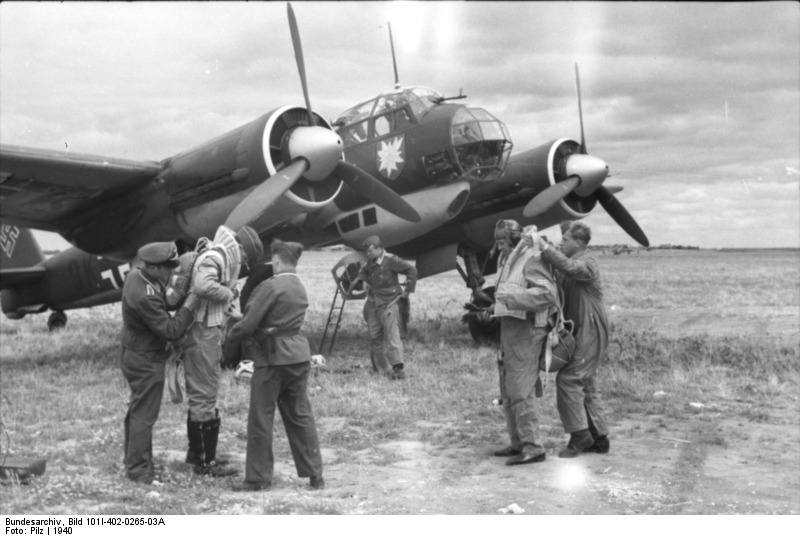 It was also used as a bomber escort, but was less maneuverable than the single-engine fighter. Germany was also defended by another heavy night fighter, the Junkers Ju88. The twin-engine prototype flew and entered service in 1936. Born as a light bomber, it became a multirole aircraft powered initially by two 1200 hp Jumo 211s and later by two 1700 hp BMW 801D-2s. The bomber version could carry up to 1,800 kilograms of bombs (maximum 2,400 kilograms in overload), while the fighter version, of which about 3,000 were produced, was equipped in the C-6 model with a radar like that of the Bf 110, whose armament it also shared. It was a mainstay of the Luftwaffe during World War II, as was the Heinkel He 111, a twin-engine medium-range bomber that flew in 1935, powered first by two DB 600 engines and then by the Jumo 211. Heavily armed, it could carry 2,000 kg of bombs and more than 7,000 were produced. It was often used to tow gliders.
It was also used as a bomber escort, but was less maneuverable than the single-engine fighter. Germany was also defended by another heavy night fighter, the Junkers Ju88. The twin-engine prototype flew and entered service in 1936. Born as a light bomber, it became a multirole aircraft powered initially by two 1200 hp Jumo 211s and later by two 1700 hp BMW 801D-2s. The bomber version could carry up to 1,800 kilograms of bombs (maximum 2,400 kilograms in overload), while the fighter version, of which about 3,000 were produced, was equipped in the C-6 model with a radar like that of the Bf 110, whose armament it also shared. It was a mainstay of the Luftwaffe during World War II, as was the Heinkel He 111, a twin-engine medium-range bomber that flew in 1935, powered first by two DB 600 engines and then by the Jumo 211. Heavily armed, it could carry 2,000 kg of bombs and more than 7,000 were produced. It was often used to tow gliders.
Messerschmitt 163. The first rocket plane in history.
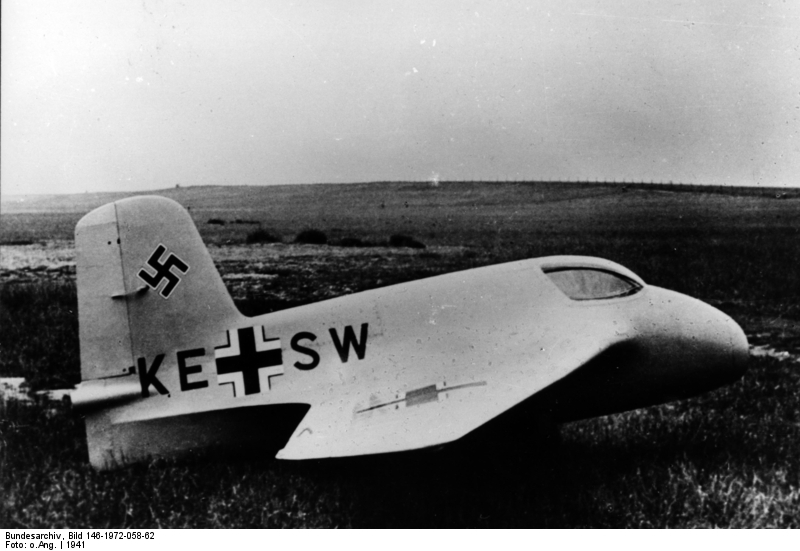 It was the first rocket-powered, piloted aircraft in history to be used in combat, and it disappointed expectations that it would succeed in solving Germany's defensive problems by stopping the Allied bombers that were ravaging German cities in large numbers.
It was the first rocket-powered, piloted aircraft in history to be used in combat, and it disappointed expectations that it would succeed in solving Germany's defensive problems by stopping the Allied bombers that were ravaging German cities in large numbers.
The Messerschmitt 163 was a stubby aircraft with a wingspan of 9.32 meters and a length of only 5.84 meters. Born as an interceptor fighter, originally equipped with a Walter HWK 509 A1 or A2 rocket engine, it could fly at a speed of more than 900 km/k at an altitude of 3,000 meters. Designed by Alexander Lippisch, it entered service in 1944 after nearly four years of development and testing. It was essentially a tailless glider whose engine provided enough thrust to allow it to quickly gain altitude and make a brief attack on Allied bomber formations with its two 30 mm cannons. When the fuel ran out, the engine would shut down and the aircraft would land as a glider. The main landing gear was released at the end of the take-off and the landing was made with a central skid. The Me 163 eventually proved to be more dangerous to pilots than to Allied aircraft: difficult to fly, susceptible to explosion due to its fuel consumption, and most importantly, vulnerable to fighter aircraft, especially when models with sufficient range to escort bomber groups into the heart of Germany came into production. By the end of the Second World War, some 300 Me 163s were in service.
Messerschmitt 262. Il precursore dei caccia moderni con motori a reazione.
Il Messerschimitt 26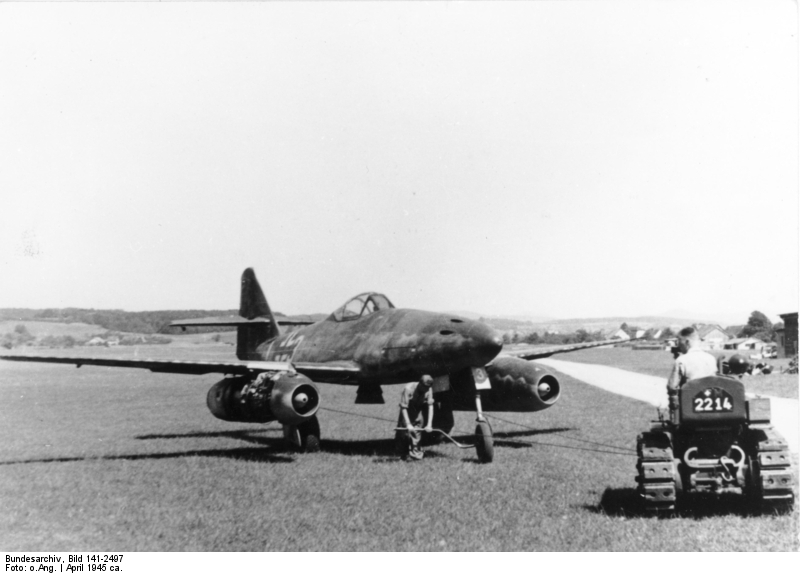 2 was the first jet aircraft in history to enter active service.
2 was the first jet aircraft in history to enter active service.
The project had its baptism in 1938 from the mind of Dr. Richard Voigt, and the characteristic structure of the plane was ready as early as the spring of 1941, but unfortunately not the engines, which suffered obvious delays in realization. The first test flight of the prototype took place on April 18, 1941 with a 690 hp Jumo 210G propeller engine, and it was not until July 18, 1942 that it was equipped with 840 kg Junkers 109-004A engines and rear landing gear according to the old fighter concept. The aircraft was already designed with arrow wings and intended for high speeds.
According to the manufacturer Messerschmitt, the aircraft had fighter characteristics and not reconnaissance characteristics as originally intended. The engines were an obvious obstacle to the final realization of the design, given the low power, still uncompetitive with that of the BF 109G and the propeller-driven Fw 190.
The obvious innovation expressed in the structure of the plane allowed the project not to be shelved, thanks also to the judgment of the ace Adolf Galland, who, flying a prototype in May 1943, declared that the plane was as if "propelled by an angel" and asked for its priority in the final realization. Construction difficulties were overcome only in November 1943 with the installation of the retractable undercarriage at the front and the realization of an increase in engine power to 900 kg, thus making it more efficient and reliable.
Production never exceeded sixty planes per month, even in the face of constant Allied bombing of German factories. The claim that the plane could also carry about 1,000 kilograms of bombs led Hitler to believe that it might be more useful in ground combat against the Allied advance, given the fears of invasion in Europe already strong in the upper echelons of the Wehrmacht. The result was an unnecessary and wasteful debate between using the extraordinary aircraft in fighter missions against Allied bombers already attacking German soil en masse, or as a fast bomber. With the advent of American high-altitude bombers, which could not be countered by anti-aircraft artillery, and the escort of modern, fast P-51 Mustangs, the Me 262's ultimate fate was as a fighter in the swarms of more than 1,000 Allied aircraft that were daily pounding cities and industries as they moved further and further inland over German soil, making the fate of the war now desperate. Hiltler's anger was compounded when he learned from Göring himself, the Luftwaffe commander, that the planned bomb load could not be transported, resulting in revised deployment plans and a consequent delay in plans to defend German soil.
It was not until November 1944 that it became clear that the Me 262 was not suitable for bombing but for hunting, so it was fitted with additional tanks to increase its range.
The final version was that of a fighter - nicknamed Schwalbe - or Swallow, instead of a bomber - nicknamed Sturmvogel or storm bird - and a two-seater trainer aircraft. Another major problem was the preparation of the pilots, who came to training on the fast jets either from brief experience on fighters or, for the more experienced pilots, from the slower but more disciplined bombers: they generally chose to train and operate the latter.
Flying the Me 262 required great skill, given its superior speed and lower maneuverability compared to the widely experienced and efficient German propeller planes of the time. Also delicate were the moments of takeoff and landing, which caused a great loss of life and Me 262s, as they were attacked by Allied fighters lurking within sight of the runways, which were built in concrete and therefore easily visible to support the weight of the aircraft and the heat produced by its engines.
Several versions entered active service: the first equipped cannons of 30 mm caliber, later increased to 50 mm and with a useful range up to 1 km., later developments came to equip the Me262 with 24 rockets of type R4M mounted under the wings. However, the night fighter version was equipped with a radar which reduced its performance and speed.
In fact, the limited use of this exceptional aircraft did not change the outcome of the war and its late entry into service was not decisive, also due to the extensive protection of the bomber flocks by the fast and maneuverable P-51, which also reported good successes against the slower maneuverable Me 262: in fact, of the 1,433 built, only 600 were in service at the end of the war, also as a result of the frequent need for maintenance and the high number of accidents and failures.
V1 and V2. The terror weapons of the Third Reich
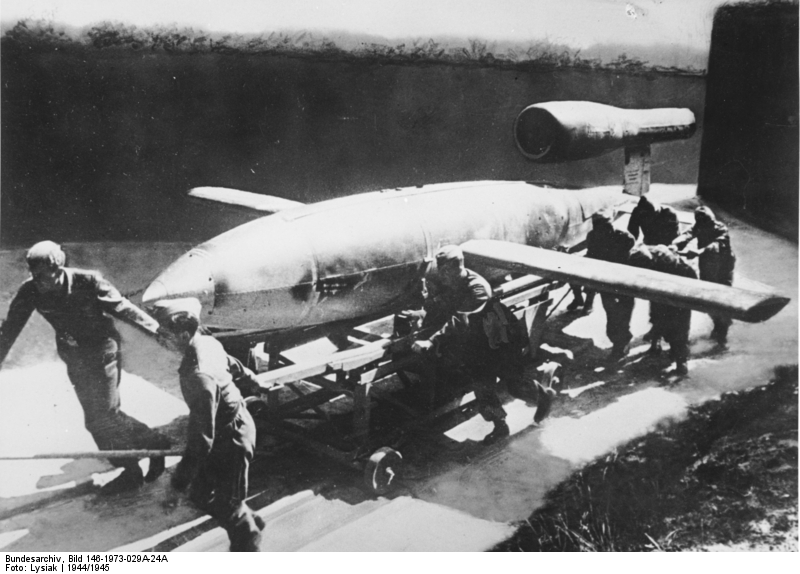 The rivalry between the Luftwaffe and the Heer, which arose when the latter declared that the V2 was an artillery weapon and therefore the responsibility of the Army, led to the development of the V1 flying bomb by the Luftwaffe. (Vergeltungswaffen 1 - Retaliatory Weapon 1).
The rivalry between the Luftwaffe and the Heer, which arose when the latter declared that the V2 was an artillery weapon and therefore the responsibility of the Army, led to the development of the V1 flying bomb by the Luftwaffe. (Vergeltungswaffen 1 - Retaliatory Weapon 1).
The first experiments with the V1, designed by Fritz Gosslau and Robert Lusser, date back to 1941, and it was not until June 1944 that the first flying bomb struck London. Powered by a pulsed jet engine, the Argus As014 could reach a speed of 640 km with a range of about 300 km, carrying a 900 kg warhead of conventional explosives. About 30,000 V1 flying bombs were produced, of which about 10,000 were aimed at England. Because it was not very fast, it was easily intercepted by British Spitfires, which could shoot it down either with on-board weapons or by bumping it legermende and sliding it off the wing. Theoretically, it could only be used as a saturation weapon, light and cheap, provided that a large number of them could be launched at the same time. The device could be launched either from a He111 type aircraft or from a ramp of clearly defined length, direction and inclination depending on the target to be hit, a gyrocompass and gyroscope controlled the pitch and yaw, when an odometer operated by a vane anemometer, set at the start in relation to the estimated wind distance, reached the estimated number of revolutions, the fuel flow was simply interrupted and the V1 would crash.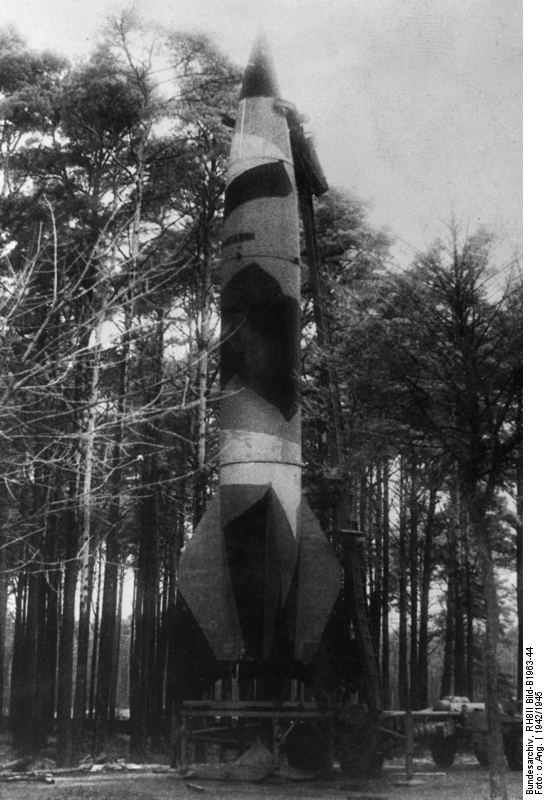 Different was the development of the V2 rocket (Vergeltungswaffe 2), considered the first ballistic missile in history, whose designer, Wernher von Braun, began his career in 1934 with the launch of the first A2 rockets, followed by the A3 model rockets, propelled by a rocket engine fueled by ethyl alcohol and water, liquid oxygen, hydrogen peroxide, sodium permanganate and water, the latter as catalysts. Guidance systems were still very rudimentary and all launches failed.
Different was the development of the V2 rocket (Vergeltungswaffe 2), considered the first ballistic missile in history, whose designer, Wernher von Braun, began his career in 1934 with the launch of the first A2 rockets, followed by the A3 model rockets, propelled by a rocket engine fueled by ethyl alcohol and water, liquid oxygen, hydrogen peroxide, sodium permanganate and water, the latter as catalysts. Guidance systems were still very rudimentary and all launches failed.
As the war approached, the military intervened in the development and construction of this weapon, which could deliver 1,000 kg of explosives to targets up to 400 km away at a speed of over 5,000 kh/h and at an altitude of about 90 km, making it undetectable by any existing aircraft or weapon.
The first flight of the A4 model, renamed V2, failed on June 13, 1942, but the successful third launch on October 3, 1942, gave a great impetus to the development and production of this forerunner of modern times in both military and space aspects. The first V2 was launched over London a few months after the V1 flying bomb.
Just under 5,000 were produced. The fuel shortage that plagued Germany in 1944 and the systematic destruction of launch sites by Allied bombers prevented this weapon from being used for massive attacks on England.
Bibliography:
Bombers of the Luftwaffe by Joachim Dressel and Manfred Griehl
German Aircraft of World War II by Al and Smith Kay
The LUftwaffe - a History by John Killen
The Kriegsmarine, U-boats and pocket battleships.
The Treaty of Versilles had decreed that Germany could not arm itself with submarines and had limited the displacement of new ships to 10,000 tons. Thus began the construction of the so-called "pocket battleships". The most famous was the Admiral Graf Spee, designed in 1932, commissioned in January 1936 and, after the Battle of the Rio de la Plata, her commander, in agreement with the officers, ordered her to sink on December 17, 1939, at the edge of territorial waters opposite the port of Montevideo. She was joined by sister ships Deutschland and Admiral Scheer, designed in 1928 and 1931, respectively, and commissioned in 1933 and 1934. They were ships with a displacement of about 12,000 tons, or about 16,000 tons fully loaded, and could reach a speed of 29 to 30 knots. Compact but technologically advanced, their performance was at least equal to the classic battleships of the time. They were armed with six 28-cm guns in two trine turrets, eight 15-cm guns, eight 3.7-cm guns on four twin rigs, and ten 2-cm machine guns.
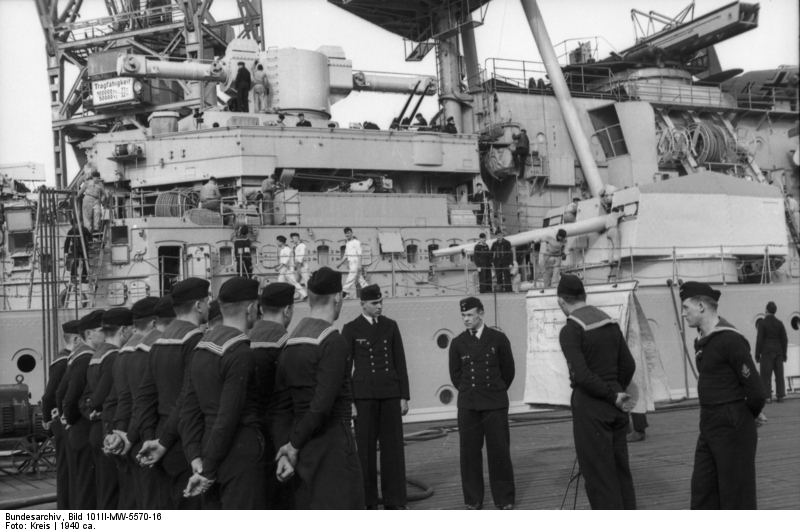 In June 1935, a treaty was signed between England and Germany that allowed Germany to equip itself with submarines and types of ships that the Treaty of Versailles had prohibited. The only restriction was that the strength of the German navy could not exceed 35 percent of that of England.
In June 1935, a treaty was signed between England and Germany that allowed Germany to equip itself with submarines and types of ships that the Treaty of Versailles had prohibited. The only restriction was that the strength of the German navy could not exceed 35 percent of that of England.
As a result, two battle cruisers were put in the pipeline: the Scharnhorst and the Gneisenau.
They were commissioned before the outbreak of war, in January 1939 and May 1938, respectively.
They were ships with a displacement of 32,000 tons or 39,0 00 fully loaded and could reach a speed of 31 knots.
They were equipped with nine 28-cm guns in three twin turrets, 12 15-cm guns in four twin and four single turrets, 14 10.5-cm guns in seven twin turrets, 16 3.7-cm guns on eight twin turrets, and 38 2-cm machine guns.
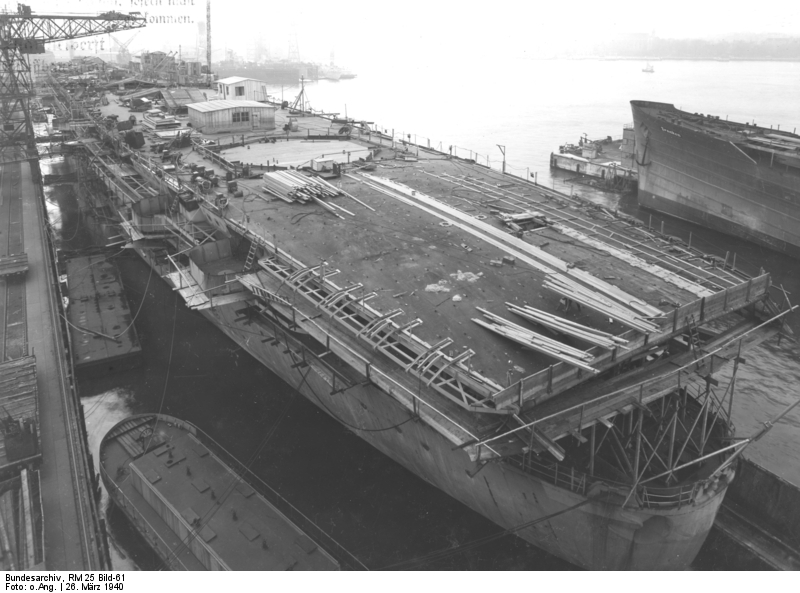 Upon entering the war, the strategic objective of the Kriegsmarine was to sink as much of the merchant shipping tonnage that supplied England with equipment and raw materials from the overseas colonies and the United States as possible; reduced supplies could cause serious difficulties in the British Empire's ability to resist, leading to its surrender.
Upon entering the war, the strategic objective of the Kriegsmarine was to sink as much of the merchant shipping tonnage that supplied England with equipment and raw materials from the overseas colonies and the United States as possible; reduced supplies could cause serious difficulties in the British Empire's ability to resist, leading to its surrender.
In 1939, the German Navy had three "pocket battleships," two battlecruisers, eight cruisers, and 22 destroyers. The two battleships Bismark and Tirpitz entered service at the beginning of the war, in August 1940 and February 1941, respectively. Their displacement was 42,000 tons, or about 52,000 fully loaded, and they could reach a speed of 30 knots. Their armament consisted of eight 38-cm guns in four twin turrets, 12 15-cm guns in six twin turrets, 16 10.5-cm guns in eight twin turrets, 16 3.7-cm small guns on eight twin turrets, and 46 2-cm machine guns in addition to eight 533-mm torpedo tubes. The 15,000-ton heavy cruiser Prinz Eugen also entered service in August 1940, and 15 more destroyers were commissioned during the war.
The aircraft carrier Graf Zeppelin was never completed.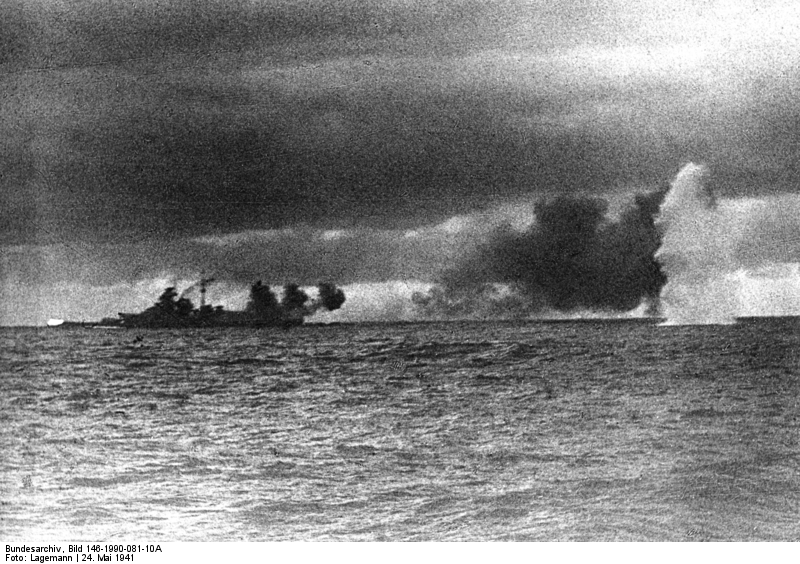 The battleships of the German Navy were superior in armor, some British ships were sunk by hits from German battleships and heavy cruisers that avavvano pierced the horizontal armor up to the santabarbara causing the ammunition stores to explode, and in the quality of the targeting systems, but the battleships did not have much luck against the British fleet, Especially the Bismark, which was sunk on May 27, 1941, almost motionless due to a jammed rudder caused by a torpedo from an aircraft torpedo bomber, after taking nearly 400 hits from the bulk of the British fleet, including the battleships Rodney and King George V.
The battleships of the German Navy were superior in armor, some British ships were sunk by hits from German battleships and heavy cruisers that avavvano pierced the horizontal armor up to the santabarbara causing the ammunition stores to explode, and in the quality of the targeting systems, but the battleships did not have much luck against the British fleet, Especially the Bismark, which was sunk on May 27, 1941, almost motionless due to a jammed rudder caused by a torpedo from an aircraft torpedo bomber, after taking nearly 400 hits from the bulk of the British fleet, including the battleships Rodney and King George V.
The main action, however, was developed by the German Navy below the surface of the sea.
The threat of German U-boats forced first the British Navy and then the U.S. Navy to escort supply convoys across the Atlantic to England and later to the Soviet Union. As a result of the 1935 treaty between England and Germany, the latter could have a submarine fleet equal to 45 percent of that of England. Early submarines were designed to operate on the surface by temporarily submerging to launch an attack or remain undetected, and sinking of enemy cargo ships was often accomplished by gunfire rather than torpedoes. Model VIIC submarines, the central model during the war, were cramped and claustrophobic with a submerged displacement of 886 tons, were nearly 67 meters long, had five 533 mm torpedo tubes and 14 torpedoes. They reached a speed of 17 knots when surfacing, which dropped to 7.5 knots when submerged with the aid of electric motors. She was equipped with an 8.8 cm gun and a 2 cm machine gun.
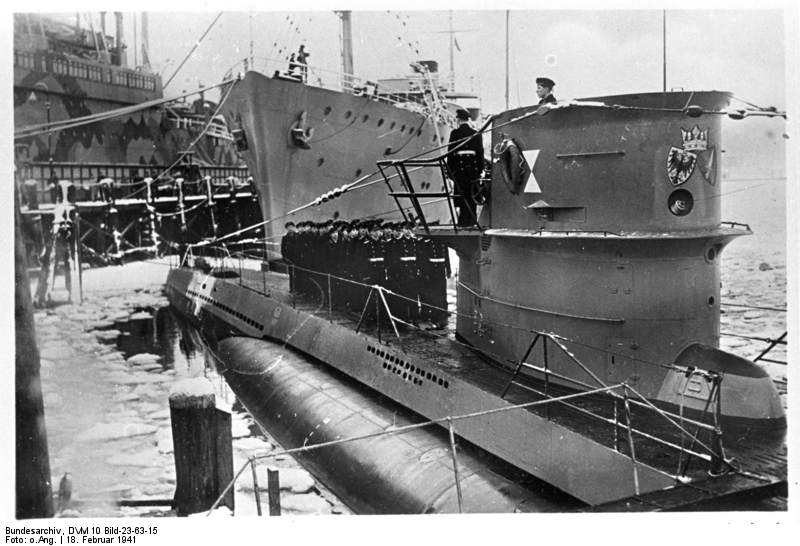 After the surrender of France, U-boats were able to operate from ocean bases on the French Atlantic coast at Lorient and St. Nazaire without the risk of being intercepted and sunk by the Royal Navy in the English Channel or stranded at bases in Germany as in World War I. England, on the other hand, had not equipped itself with patrol aircraft of sufficient range to cover the Atlantic, and somehow all navies, including the Royal Navy, did not consider submarines a real threat. When the war began, merchant ships were immediately grouped into convoys, escorted as far as possible by aircraft and anti-submarine warships, but the German naval services were able to decode messages from the British merchant marine so as to know where the convoys would form, a submarine would follow them, wait for others to reach the area, and then attack in a formation called a wolf pack. At the turn of 1940 and 1941, ocean-going submarines, using wolf pack tactics, and the Luftwaffe, using long-range FW200 aircraft, sank hundreds of thousands of tons of shipping.
After the surrender of France, U-boats were able to operate from ocean bases on the French Atlantic coast at Lorient and St. Nazaire without the risk of being intercepted and sunk by the Royal Navy in the English Channel or stranded at bases in Germany as in World War I. England, on the other hand, had not equipped itself with patrol aircraft of sufficient range to cover the Atlantic, and somehow all navies, including the Royal Navy, did not consider submarines a real threat. When the war began, merchant ships were immediately grouped into convoys, escorted as far as possible by aircraft and anti-submarine warships, but the German naval services were able to decode messages from the British merchant marine so as to know where the convoys would form, a submarine would follow them, wait for others to reach the area, and then attack in a formation called a wolf pack. At the turn of 1940 and 1941, ocean-going submarines, using wolf pack tactics, and the Luftwaffe, using long-range FW200 aircraft, sank hundreds of thousands of tons of shipping.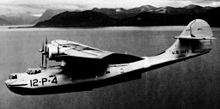 In mid-1941, the British acquired long-range patrol planes, including American Catalinas transferred to England under the Rent and Loan Act, and subjected the crews to specific and intensive training, obtaining in return a marked improvement in convoy defense. Defense at sea was improved by the increase in escort ships, but also by the entry into service of U.S. destroyers ceded to the Royal Navy, by improved sonar, by the availability of radar capable of intercepting submarines on the surface, and by the inevitable anti-submarine training. In December 1941, the aircraft carrier Audacity also began escorting convoys.
In mid-1941, the British acquired long-range patrol planes, including American Catalinas transferred to England under the Rent and Loan Act, and subjected the crews to specific and intensive training, obtaining in return a marked improvement in convoy defense. Defense at sea was improved by the increase in escort ships, but also by the entry into service of U.S. destroyers ceded to the Royal Navy, by improved sonar, by the availability of radar capable of intercepting submarines on the surface, and by the inevitable anti-submarine training. In December 1941, the aircraft carrier Audacity also began escorting convoys.
Faced with increasing difficulties in the North Atlantic, U-boat action began to shift in early 1942 to the eastern seaboard of the United States, which had entered the war after the Japanese attack on Pearl Harbor. The U.S. Navy was caught completely unprepared: the Germans were able to intercept all merchant radio traffic, ships sailed with their lights on, and the coast was illuminated by lights in the streets and houses. It was a disaster. Over 3,500,000 tons of shipping were sunk in six months.
By the end of 1942, in addition to escort ships, convoys were equipped with support ships capable of hunting U-boats, and air cover was provided by the newly commissioned B-24 Liberator bombers, equipped with the latest radar: they were able to detect the small snorkel of a diving U-boat at periscope height, changing air and recharging its batteries. Despite the invention of the acoustic torpedo, the Germans had lost the technological race, and they were also outmatched tactically by the Allies, who were now sinking more U-boats than the German shipbuilding industry could produce, thanks in part to Allied bombing of French factories and shipyards.
Germany produced more than 1,100 submarines, lost nearly 790, but most importantly, an estimated 30,000 sailors embarked on the U-boats lost their lives.

